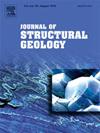High-temperature deformation of clinopyroxene–plagioclase aggregates under wet conditions
IF 2.9
2区 地球科学
Q2 GEOSCIENCES, MULTIDISCIPLINARY
引用次数: 0
Abstract
Understanding the rheological properties of the continental lower crust (CLC), particularly its response to water, is vital for comprehending various geodynamic processes within the Earth. In this study, two groups of clinopyroxene–plagioclase aggregates, which serve as representative samples of the CLC, were hot pressed in a Paterson gas-medium apparatus with “as is” and additional water. Subsequently, deformation tests were conducted on the hot-pressed samples in the same apparatus, under a confining pressure of 300 MPa, temperature of 1173–1423 K, and strain rates of 6 × 10−6 to 2 × 10−4 s−1. Mechanical data revealed that axial stresses between 15 and 464 MPa and total accumulated finite strain values between 12 % and 20 %. The resulting mechanical data were analyzed and fitted to a flow law, yielding a stress exponent (n) of 3.6 ± 0.6 and activation energy (Q) of 504 ± 85 kJ/mol for the “as is” samples, and n = 3.7 ± 1.4 and Q = 347 ± 48 kJ/mol for water-added samples. Microstructural observations revealed that the deformed samples exhibited a shape-preferred orientation (SPO) and crystallographic preferred orientation (CPO) with subgrain boundaries in coarse-grained domains (constituting ∼80 vol%), indicating that the primary deformation mechanism is dislocation creep. Additionally, the presence of melt, neoformed phases (olivine + orthopyroxene) and abundant fine-grained particles (<10 μm) all show subsidiary dissolution-precipitation creep, and the subsidiary dissolution-precipitation creep played an important role under higher temperature and higher water content conditions. The overall reduction in average grain size resulted in deformation under the grain-size-sensitive creep regime, leading to a notable decrease in sample strength. Overall, these findings confirm the “jelly sandwich” concept of the continental lithosphere by showing that the lower crust is relatively weaker than the upper crust and uppermost mantle.
斜辉石-斜长石聚集体在潮湿条件下的高温变形
了解大陆下地壳(CLC)的流变特性,特别是它对水的响应,对于理解地球内部的各种地球动力学过程至关重要。在本研究中,两组斜辉石-斜长石聚集体作为CLC的代表性样品,在Paterson气-介质装置中以“原样”和额外的水进行热压。随后,在同一设备上对热压试样进行了变形试验,围压为300 MPa,温度为1173 ~ 1423 K,应变速率为6 × 10−6 ~ 2 × 10−4 s−1。力学数据显示,轴向应力在15 ~ 464 MPa之间,总累积有限应变值在12% ~ 20%之间。对所得力学数据进行分析并拟合,得到原状试样的应力指数(n)为3.6±0.6,活化能(Q)为504±85 kJ/mol,加水试样的n = 3.7±1.4,Q = 347±48 kJ/mol。显微组织观察表明,变形后的样品在粗晶区域表现出形状优先取向(SPO)和晶体优先取向(CPO),并具有亚晶界(约占80%),表明变形的主要机制是位错蠕变。此外,熔体、新形成相(橄榄石+正辉石)和丰富的细晶颗粒(<10 μm)均表现出辅助溶蚀-析出蠕变,且在高温高含水量条件下,辅助溶蚀-析出蠕变发挥了重要作用。平均晶粒尺寸的整体减小导致了晶粒尺寸敏感蠕变状态下的变形,导致试样强度显著降低。总的来说,这些发现证实了大陆岩石圈的“果冻三明治”概念,表明下地壳相对弱于上地壳和上地幔。
本文章由计算机程序翻译,如有差异,请以英文原文为准。
求助全文
约1分钟内获得全文
求助全文
来源期刊

Journal of Structural Geology
地学-地球科学综合
CiteScore
6.00
自引率
19.40%
发文量
192
审稿时长
15.7 weeks
期刊介绍:
The Journal of Structural Geology publishes process-oriented investigations about structural geology using appropriate combinations of analog and digital field data, seismic reflection data, satellite-derived data, geometric analysis, kinematic analysis, laboratory experiments, computer visualizations, and analogue or numerical modelling on all scales. Contributions are encouraged to draw perspectives from rheology, rock mechanics, geophysics,metamorphism, sedimentology, petroleum geology, economic geology, geodynamics, planetary geology, tectonics and neotectonics to provide a more powerful understanding of deformation processes and systems. Given the visual nature of the discipline, supplementary materials that portray the data and analysis in 3-D or quasi 3-D manners, including the use of videos, and/or graphical abstracts can significantly strengthen the impact of contributions.
 求助内容:
求助内容: 应助结果提醒方式:
应助结果提醒方式:


